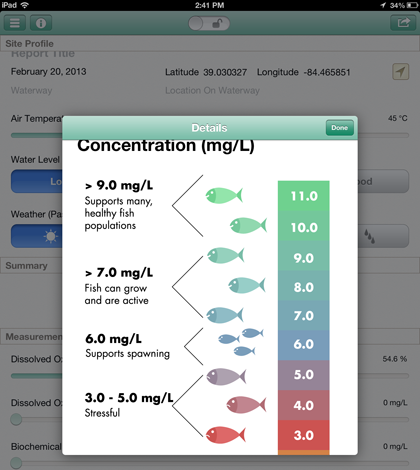WaterQuality app makes tracking data easy and educational

A new mobile application for use on iPad, iPhone and iPod Touch devices is changing the way water monitoring data is cataloged.
The app, called WaterQuality, is the result of a collaboration between Northern Kentucky University and the Foundation for Ohio River Education, which teamed up to improve the efficiency of water quality monitoring, while at the same time, provide a platform for learning.
Led by Steve Kerlin, director of the NKU Center for Environmental Education, a team began developing the program in the spring of 2012 after receiving a mini-grant from the NKU College of Education and Human Services. WaterQuality version 1.0 was released in October 2012.
WaterQuality allows users to create a profile for a monitoring site in which they can enter chemical and bacterial monitoring data obtained from standard monitoring equipment. The app then provides graphs and illustrations that define and provide healthy ranges for various water quality measurables.
Since the app can be shared on an unlimited number of devices after its initial download, the program is ideal for sharing within school systems. However, the program has a wide demographic—it was constructed to be used by scientists, citizens, government agencies, teachers and students.
The app is currently being used in K-12 outdoor field trips, college science courses and teacher developmental courses. Scientists and governmental agencies including the Environmental Protection Agency have also expressed support for the program.
Steve Kerlin thinks that the program’s interactive facet is WaterQuality’s main appeal.
“In the science education field, one of the terms we have is called ‘educated curriculum.’ The idea is that while you are using something, you are also learning,” Kerlin said. “It’s not just a tool to be used to have a means to an end, you are also learning along the way. And so we’ve designed it in that way.”
The program provides 11 different chemical and bacterial parameters to be measured: dissolved oxygen, biochemical oxygen demand, E.coli, fecal coliform, pH, water temperature, phosphates, nitrates, turbidity, conductivity and hardness.
WaterQuality’s developmental team is confident that the program will help users make sense of complicated data. One feature in the data entry section even tells users what their measurements mean.
“A lot of times we’re finding teachers and student science monitors gather a number but don’t really understand what the number means or if it’s in acceptable parameters,” Kerlin said. “So what it does is allow you to log data, but also to make sense of that data.”

WaterQuality app macroinvertebrate entry screen
The program is also equipped with a digital field guide with pictures and information on various macroinvertebrate species.The presence of a variety of invertebrates is a key indicator of healthy waterways that are capable of sustaining diverse life.
Once users identify macroinvertebrates present in their monitoring location, the app can calculate how healthy a site’s water is through the Pollution Tolerance Index.
The index is used by many science and education groups and state organizations.“If you find a large diversity of macroinvertebrates, that means your stream is healthy,” Kerlin said. “If you only find macroinvertebrates and other aquatic species that are in, for instance, a poor category, like leeches and bloodworms, if you only find them, the water quality is poor. There is something going on. It’s a calculation based on groupings of those organisms.”
WaterQuality’s pallet of tools and reference information allows for a more interactive, informative monitoring experience that highlights how new technologies could be instrumental in the future of science and environmental education.
WaterQuality version 1.1 is currently available for $4.99 on iTunes, with an updated version scheduled for release in May. Revenue from app sales will help fund the future development of WaterQuality and will also be used to assist water quality education programs.




Alice Walker
November 22, 2014 at 9:36 pm
This app has been hiijacked or something. I’ve downloaded it twice and there is no way to navigate around the app, other than data entry. When I tried to contact the developer through iTunes Store, I was connected to what I assume was a Russian site (Cyrillic alphabet) that was selling what looks like centrifuges. Don’t buy it until it’s fixed.